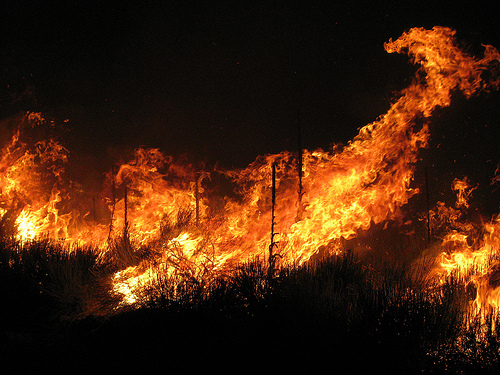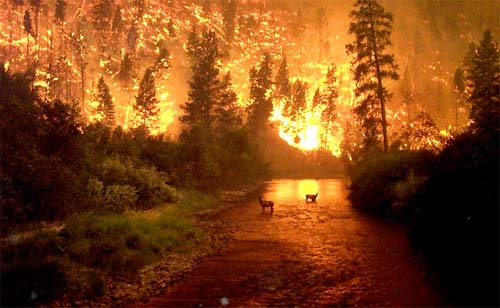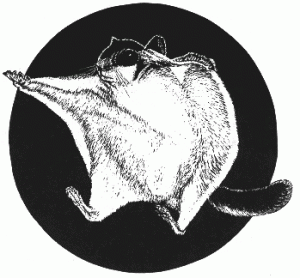
Fire’s Role in the Lives of People and the Forests of the Pacific Northwest
Activities for grade K-12
(Adapted from Fire in Pacific Northwest Ecosystems, Environmental Education Association of Oregon and Pacific Northwest Coordinating Group, 1997.)
Compiled by Susan Duncan, Assistant Director of Environmental Education
Washington Forest Protection Association
Kindergarten
Celebrating Fire
Gather students into a sharing circle. Suggest that fire can be a useful tool. People of many different traditions use fire for celebrations. Describe one example such as birthdays by burning candles on a cake. Invite the students to imagine and describe how burning candles smell, look, taste, sound and feel. Ask students to explain how they keep the fire safe.
Give the students drawing materials to create a picture of another kind of special day where fire is used to celebrate e.g. Olympic Torch, wedding, holidays, etc. Invite them to describe the sights, smells, sounds, tastes and textures in their picture. Also, ask them to explain how the fire is kept safe.
First Grade
Fire Bugs
Have students select and draw an insect they might find in a forest with its food source and shelter. Ask them to think about what the insect might do if a fire passed through the forest as they share their drawing with a partner.
Explain that fire tends to favor insects with wings. They can fly away when the flames begin and return afterwards to take advantage of the decaying wood for their new nests and shelter. Flying insects are often attracted to heat and light. Because the sweet tree sap, leaves and bark that attract many crawling insects are burned in a fire, many insects such as caterpillars cannot find enough food in a burned area to survive and will need to wait for new plants to grow. Once the rain moistens the burned layers, and the soil begins to be broken up by burrowing mammals, insects at every stage of life begin to find food and shelter. Then, the woodpeckers and other wildlife, which depend on them for food, return as well.
(People have used fire to protect themselves from unwanted flying insects. Smoke from fire can be used to “smoke” meat so it is protected from insects that lay their eggs in rotting meat. This kind of meat is often called, “jerky,” and can be eaten by people later. Some people still use smoke to keep bees away from them so they can collect their honey. A smoky campfire can also keep bugs away.)
Add the following sentence to their picture, and ask students to finish writing it:
“When a fire comes, this insect would________________________________________, and then,________________________________.”
Second Grade
A Tool for Growing New Plants
Fire can be a useful tool if it is under control. Explain that people have used “controlled” fires to burn trees in areas where they hunt for food or graze horses. People have carefully used fire to burn the shape of the inside of a canoe into a log from a cedar tree. Controlled fires help prairie grasses and huckleberry bushes grow. They also burn dead and diseased trees or tall brush that can move fires up to the tops of large trees whose bark might otherwise have protected them from the fire.
Fire helps put nutrients back in the soil for new plants to grow and opens the forest so more sunlight reaches the forest floor.
Fire helps new plants in the forest three ways:
• Opens the area around the seed to sunlight
• Removes the “coat” on some seeds so they become moist and begin growing
• Improves the quality of the soil for the seed to grow by providing fresh nutrients and eliminating diseases.
Hold up a seed cone from a pine tree for the students. Explain that the cone has more than one seed and could grow many trees. Act out a controlled fire passing through a forest of tall healthy trees interspersed with dead trees. The dead trees burn to create soil and open up the forest to the light of a student that represents the sun. Other students acting as seeds from the cone remove their ìcoatsî and begin to grow with their toes absorbing nutrients like roots.
Third Grade
Fire’s Effects on Streams
Ask students to compare and contrast the habitat of two crayfish: one that lives in a mountain stream with natural seasonal changes and another crayfish whose forested stream has recently been changed by fire. Make a class list that shows the comparisons discussed.
Discuss the effects of losing trees to fire in more detail: water temperature (increases), sedimentation (increases), amount of water flow (increases) and amount of nutrients (increase).
Effects of increased sedimentation:
Reduction in size of territory
Difficulty seeing food in water clouded with sediment
Fewer resting and hiding places as sediment fills bottom of stream
Effects of temperature increase:
Less oxygen in the water
More prone to disease
Effects of increase water flow:
Washes away logs to hide under
Difficult to find safe place to rest
Effects of more nutrients:
More algae, which can reduce oxygen even more
More insects on which to feed
To summarize, invite students to write a news flash and give a brief report about something that is happening to the crayfish because of changes in its habitat due to the fire.
Fourth Grade
Fire and Water
Cooling fire with water is one essential step for putting out forest fires so when it rains firefighters, especially those scooping water from nearby lakes with helicopters are grateful. The other two essential steps for extinguishing forest fires include: building a fire line, which removes any fuel the fire could use, and smothering the fire so it can not get any oxygen.
To learn these essential forest firefighting skills, play a math game called, “Water, Dirt, Fire Line” with the following rules:
• Play in groups of two.
• Count, “1,2,3” and then, say one way to help extinguish the fire (Water, Dirt, Fire Line.)
• Keep track of how many times each word is picked by keeping a record in a table.
After 5 rounds, write right down the probability for each word being picked. (Make a fraction with the number of times the word is selected over the total number of words said. In this case, 2 people times 5 rounds equals 10 total words. Fore example, read it out loud as “Water was said 3 times out of 10. “)
As a class, compare the probability that each word would be selected and determine which word was selected most often.
Discuss the probability that using only one method would put out the forest fire. Then, discuss what could be done to increase the chances of putting out a forest fire.
Fifth Grade
Succession after a Forest Fire
After a forest fire, the environment will pass thorough a series of stages as it recovers. The amount of time for recovery depends on the duration and temperature of the fire. The stages vary from place to place, but generally the environmental conditions favor the following types of plants and animals:
0-5 years -Grasses, wildflowers and ferns thrive on the nutrients provided to the soil from the ash. Shrub seedlings begin to grow from root systems. Tree seedlings begin to grow. Snags provide habitat.
6-25 years-Shrubs and tree seedling grow larger and provide shade to grasses and other plants. Plenty of berries leaves and seeds for birds and mammals.
26-50 years-Deciduous trees such as alder and maple shade most of the forest and conifers reach the canopy.
51-150 years-Deciduous trees begin to mature and die allowing confers to grow in the sunlight and become the dominant species.
Conifers make up the canopy layer,
Use these brief descriptions to infer what kinds of wildlife and plants might be present in a recovering forest as it passes through these stages, draw a series of forest pictures like a comic book that shows these changes over time.
Sixth Grade
Fire and Weather
Invite students to create a diagram a healthy forest and describe its influence on the weather. Invite them to create a second diagram to help them answer the question, “What direct relationships exist between forest fires and weather?” Here’s a list of variables to consider:
Humidity Soil Temperature
Wind Speed Rainfall
Air temperature Snowmelt
Sunlight Lightning
Flooding
Seventh Grade
Fire: A Prescription for Diversity
The natural forces of earth, wind, fire and water combine to create diverse habitats for many species. Plants and animals adapted to the forests of the Pacific Northwest have experienced the effects of naturally occurring fires for thousands of years. How much a forest burns varies based on its topography, amount of fuel and weather. Fire creates a “mosaic” of forests in many different stages: grass, wildflowers and ferns; shrubs and small saplings; mature deciduous trees; and mature conifers. This mosaic creates edges and variations in habitat so diverse species can survive.
Prescribed fires are used by foresters to recreate a variety of habitats or “mosaics”, which were historically created by fire. Prescribed fires are planned by professionals and occur in the right place at the right time. Three kinds of prescribed fires are often used:
Slash Burning – removes fuels after trees have been harvested and prepares the ground for planting new seedlings.
Underburning – a fire that burns below the tree canopy to reduce the competition for sunlight between the brush and tree seedlings, reduces insect populations, opens cones (in the pine forest) and reduces fuels that might otherwise cause the canopy to burn.
Range Burning – a low intensity fire that burns unwanted grass, shrubs, noxious weeds and trees to improve the quality of food for range animals and wildlife.
Select a forest or range area familiar to the students, and discuss how the diversity of species in the habitat might be improved using prescribed fire. Work in small groups to draw a before and after map of the area noting the location and kind of prescribed burn recommended. As each group to describe the mosaic of habitats that will be created by their plan with the class while making a class list of the advantages and disadvantages of prescribed burns in the area.
Eighth Grade
Wildfires and Urban Populations
Protecting a home from wildfire can be as simple as 1,2,3, but steep slopes and windswept exposures add extra challenge. Fires grow with fuel, oxygen and heat. Brainstorm how a home could be landscaped to reduce a fire’s access to fuel, oxygen and heat.
By setting up a zone of defense, a home can be protected from wildfire. Invite students to create a model with the landscaping for a home in a fire prone area. The model would clearly shows these three zones:
Zone 1- Moist and Trim
This is the last line of defense before the house needs to begin at the house and go 50 feet out. Trees, shrubs and plants need to be low growing and at least 10 feet away from the house. Plants that hold a lot of water can be used to make a greenbelt and fire resistant plants that do not have resin in them are best.
Zone 2 – Low and Sparse
This is the second line of defense and extends 100 feet away from the house. Native plants and low growing shrubs that are drought tolerant. It is also important to remove any dry leaves and other flammable material.
Zone 3 – High and Clean
This is the first line of defense. Native trees that have been thinned and dry debris on the ground removed. Ten feet spaces between trees and branched trimmed to ten feet can prevent fire from spreading.
Ninth Grade
Economies Battle the Bugs
A 450 year old Douglas fir that is 10 feet in diameter can be killed by a fire, but the wood beneath its charred surface is marketable, at least until the bugs begin to drill holes through it. Many board feet of lumber were salvaged from the burned timber of the 1933 Tillamook Burn. The amount of timber killed from the fire was equal to all the lumber used in the 48 states in 1932.
Invite students to write a position paper by researching current issues regarding salvaging timber that has been damaged by fires and the existing demand for lumber. Ask them to note the tradeoffs and costs.
Tenth Grade
History of Fire Suppression
Use drama to tell the story of fire suppression. Assign a group of three students to create a “tableau” or still life representation of how people have decide to manage the actual and potential risk of wildfire using the following timeline:
1873 American Association for the Advancement of Science lobbied for laws to preserve timber. Congress passed the Timber Culture Act, which promotes tree planting.
1898 Theodore Roosevelt created the Division of Forestry headed by Gifford Pinchot. Pinchot advocated multiple use of the forests and the US Forest Service began the policy of fire prevention and total fire suppression.
1916 US Department of the Interior- National Park Service was established. Policy was to maintain a strict fire suppression policy while USFS allowed fires to burn in remote areas.
1919 USFS adopted policy of intensive fire suppression.
1924 Clark-McNary Act expanded the Weeks Act by providing a solid basis for federal and state cooperation in wildfire protection, production of trees for reforestation and expanded fire protection to private lands.
1925 Cooperative agreement between USFS and War Department of 1921 expanded for airplane surveillance in Washington, Oregon, Idaho and Montana.
1935 USFS adopts ì10 a.m. policyî after three bad fires. The policy stated that foresters would strive to contain all fires by 10 a.m. the day after they started.
1940 First parachute jump on a forest fire.
1948 Smokey Bear came into being.
1959 A forest fire laboratory was established in Macon, Georgia to work on fire problems nationally, but was to specifically look at fire in hardwoods.
1963 Leopold Report acknowledged the historical role of fire and advised starting planned ignition burns to maintain flora and fauna.
1973 The new National Fire Danger Rating System is put into widespread use.
1978 USFS begins the ìlet burnî program for naturally occurring fires in wilderness areas.
1990 Yellowstone National Park begins re-evaluation of ìnatural fireî policy.
1994 Fourteen fire fighters killed on Storm King Mountain Fire in Colorado. Fires in Wenatchee, Washington burned 135,000 acres and destroyed 22 homes.
2000 President Clinton requested a report whose finding led to the adoption of the National Fire Plan. The plan recommended active management in the form of mechanical thinning and prescribed fires to return forests on federal lands to historic levels of density and species diversity.
11th Grade
Air Quality Debate
Depending on topography and weather, air quality can be significantly impacted by fire. Foresters planning prescribed fires must consider a variety of factors including both locations of urban centers as well as protecting visibility in wilderness areas and national parks.
Invite student to prepare for a debate regarding the prescribed burn of a forested area to reduce fuel below the canopy in an area near a national park. After multiple options are proposed and considered, work as a class to reach consensus on the best practice for the area at this particular time.
12th Grade
What Next?
Fire ecologists estimate that Oregon and Washington combined have about 10 million acres of Condition Class 3 forestland that has the highest risk for crown fires. Planning for fire can prevent tragic loss as well as sustain the natural benefits fire has provided to the unique ecosystems of the Pacific Northwest. Invite one half of the class to work with in small groups to make a flow chart that shows the risks to the environment from a wildfire in a wilderness area. Invite the other half of the class to work in pairs to create a flow chart showing the risks to people from a wildfire in an urban area. Have groups compare their flowcharts and determine what risks are could be controlled and how. Work with students to identify people and organizations in the community and describe the active roles that can be taken to control the risks associated with fire.





 by Victoria Lewis
by Victoria Lewis